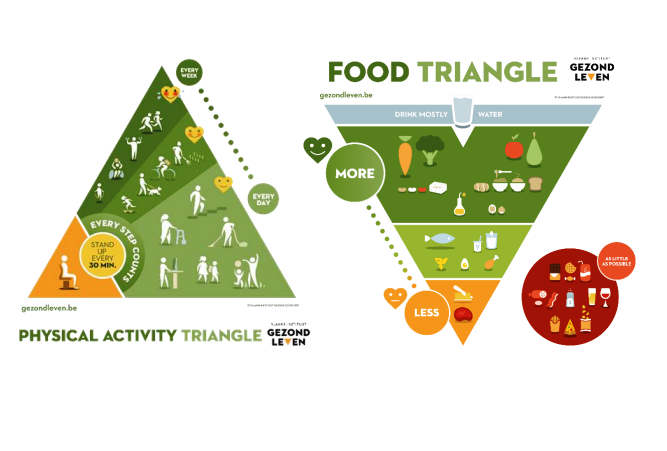|
Introduction Eating is undoubtedly one of life's greatest pleasures. The sight, smell, taste, and texture of food are just a few characteristics that entice us eat what we eat. History, religion, culture, friends, family and the environment also influence our food choices. And hopefully, we also base our food choices on nutrition and health. A healthy diet provides the right balance of carbohydrates, fats, protein, vitamins and minerals. This balance can be obtained from eating a variety of foods that are available, affordable, and enjoyable. Knowing how to select and plan a healthy meal can be important for staying healthy and/or improving your health.  Source: Flemish Institute Healthy Living Source: Flemish Institute Healthy Living How to maintain a healthy diet To maintain a healthy diet, consider the following: Variety: Eat a variety of foods from all groups of The Food Triangle. No single food contains all of the nutrients your body needs to function properly. Eating foods from the five food groups ensures that your body is getting all the nutrients it needs. It also provides a large variety of tastes and textures to enjoy! Balance: All adults need to consume at least the minimum number of servings from each food group every day. The goal is to obtain adequate amounts of nutrients by making food choices from each food group in The Food Triangle. Children, adolescents and seniors have different nutrient requirements. Triangles are available for these specific populations as well: for children or adolescents click here. Moderation: Remember, there are no good foods or bad foods. Watching portion sizes of some of your favorite "not so healthy" foods or beverages will help you to maintain the appropriate weight for your age, gender, and activity level. Safety: Be sure to keep foods safe to eat through proper handling, storage and cooking methods. Also, use proper handwashing techniques and sanitation. To maintain good health, use the Food Triangle to guide your food choices. Nutrients and Other Food Components All foods contain nutrients and other components. Nutrients can be broken down into two groups- macronutrients and micronutrients. Macronutrients include carbohydrates (starches and sugars), proteins (meat, dry beans, eggs), and fats (oils and margarine). Macronutrients provide energy (calories). Micronutrients include vitamins and minerals. These are needed in much smaller amounts, and unlike macronutrients do not provide energy. It is best to obtain these nutrients from whole foods rather than vitamin or other supplements. Other components found in foods that are not classified as nutrients include water, fiber and phytochemicals. Fiber is the indigestible part of plants that helps maintain bowel health and may reduce the risk of diabetes, heart disease and some cancers. Plant foods also contain several phytochemicals that may aid in the prevention of cancer, heart disease and other chronic conditions. Phytochemicals make up the taste, texture and smell of foods. Ongoing research is being done to determine the roles that these substances play in maintaining health. Like vitamins and minerals, phytochemicals should be obtained from a variety of plant-based foods, rather than supplements. You Are What You Eat Studies show that a healthy lifestyle, which includes balanced meals and regular physical activity, can play a role in reducing the risks of several chronic diseases and premature death. Poor eating habits and lack of physical activity are risk factors for several chronic diseases among adults including: - Obesity - Heart disease - Stroke - Hypertension - Diabetes - Some cancers - Osteoarthritis While the focus of the media is so often on weight loss, people concerned about health should focus on healthier eating habits and physical fitness for a lifetime. You can learn more about adopting a healthier lifestyle by talking to a registered dietitian and your health care provider. Christiaan Janssens
CRO Akwa Wellness Sources and References: Belin, R.J., et al., Diet quality and the risk of cardiovascular disease: the Women’s Health Initiative (WHI). Am J Clin Nutr, 2011. 94(1): p. 49-57. World Cancer Research Fund and American Institute for Cancer Research, Continuous Update Project Report Summary. Food, Nutrition, Physical Activity, and the Prevention of Colorectal Cancer, 2011. "Nutrition Plate Unveiled, Replacing Food Pyramid". The New York Times. 2 June 2011. Websites: The Food Pyramid Healthy Eating Plate & Healthy Eating Pyramid Healthy Living 2017 Healthy Eating
1 Comment
9/16/2023 05:18:45 am
This nutrition article is a nutritional goldmine! It's packed with well-researched information, practical tips, and valuable insights for maintaining a healthy and balanced diet. Thank you for sharing such a valuable resource for better well-being!
Reply
Leave a Reply. |
AuthorDrs. Christiaan Janssens Archive
Augustus 2019
Categories |
 RSS-feed
RSS-feed
